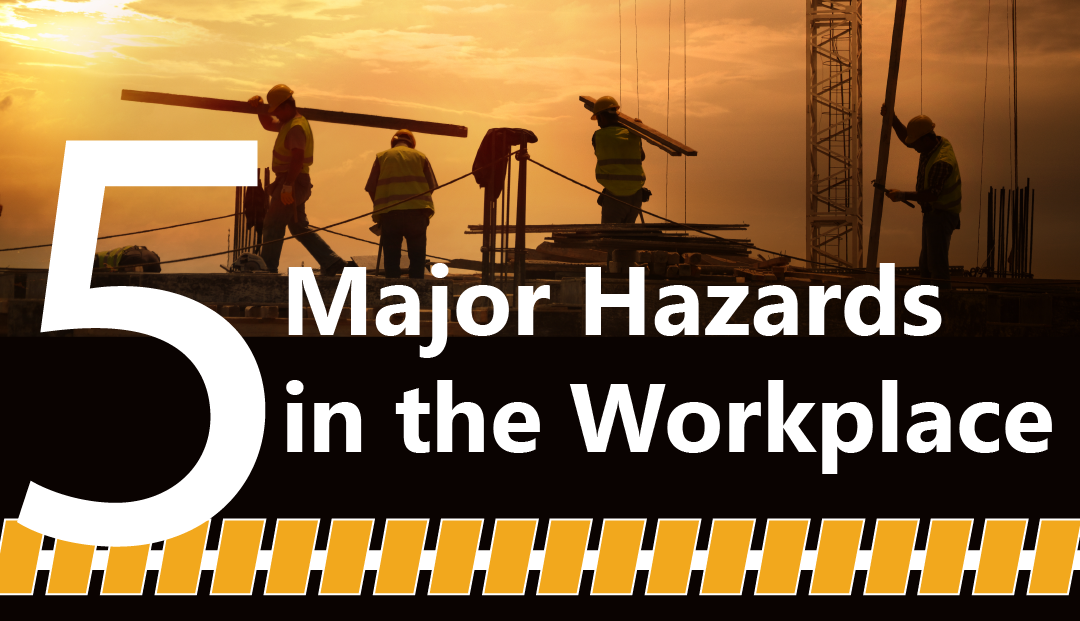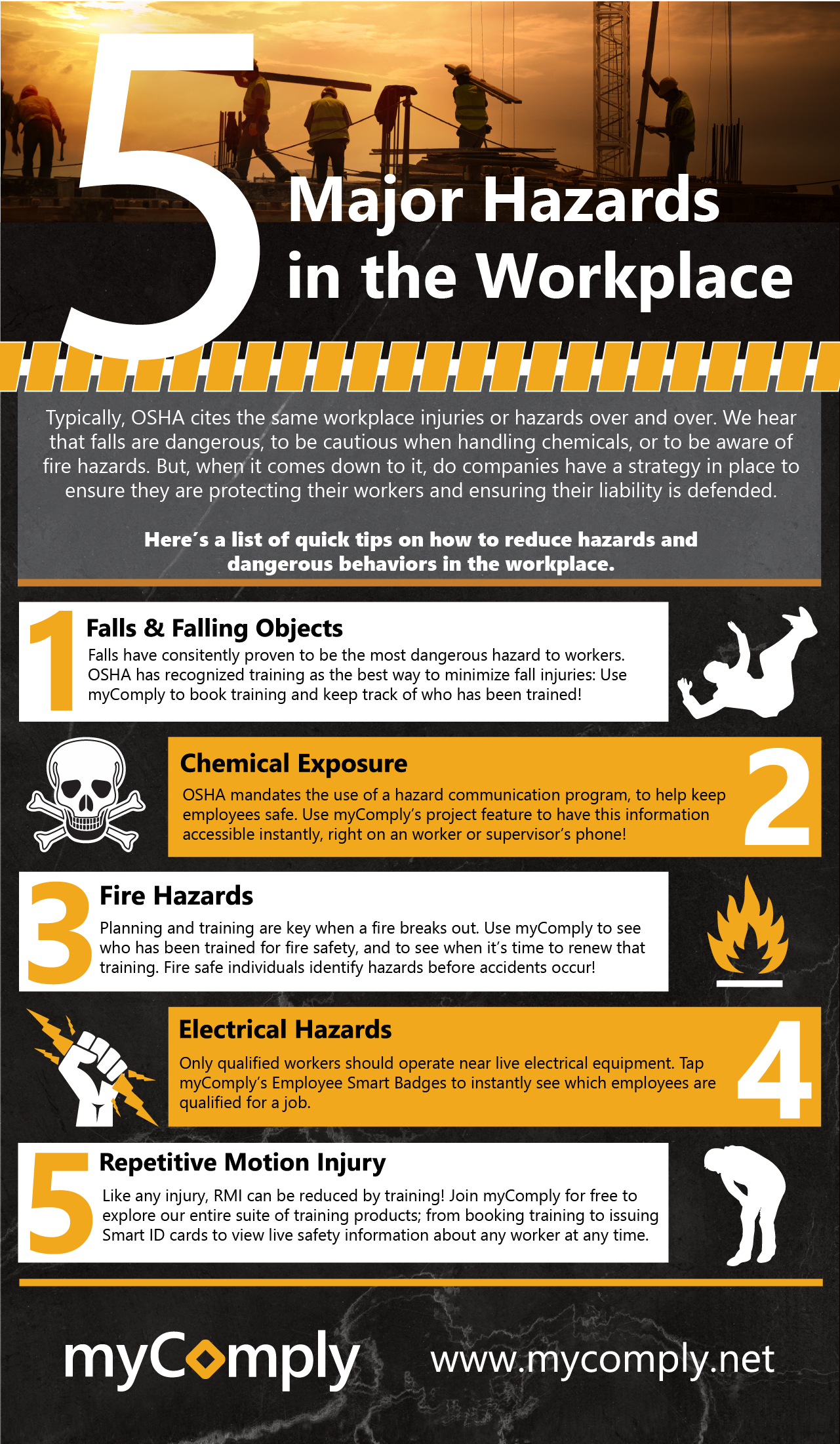Typically, OSHA cites the same workplace injuries or hazards over and over. We hear that falls are dangerous, to be cautious when handling chemicals, or to be aware of fire hazards. But, when it comes down to it, do companies have a strategy in place to ensure they are protecting their workers and ensuring their liability is defended?
What are the 5 major hazards in the workplace?
- Falls and Falling Objects
- Chemical Exposure
- Fire Hazards
- Electrical Hazards
- Repetitive Motion Injury
Where OSHA cites the most accidents is in the construction industry, which is not really a surprise due to the dangerous work performed on job sites. However, no matter the industry there are workplace hazards – including sitting at a desk in a cozy office job.
At the heart of avoiding accidents or identifying hazards is ensuring your workplace or job site has individuals performing tasks who are properly trained. Training is the key to prevention! You’ll see this trend in our “Prevention Tip(s)!” below.
Workplace Hazard #1: Falls and Falling Objects
- Approximately 19,565 people die in the U.S. annually due to injuries caused by unintentional falls
- Slips, trip and fall injuries cost employers approximately $40,000 per incident;
- About 9.2 million people were treated in emergency rooms for fall-related injuries in 2016.
- 65% of fall-related injuries occur as a result of falls from same-level walking surfaces;
- In 2017, there were 366 fatal falls to a lower level out of 971 construction fatalities
- CFR 1926.501 Fall Protection is the single most cited workplace violation by the OSHA
- 85% of worker’s compensation claims are attributed to employees slipping on slick floors (Industrial Safety & Occupational Health Markets 5th edition)
Prevention Tip!
Since 2012, OSHA has recognized training as the best way to minimize fall injuries: Use myComply to book training and keep track of who has been trained!
Workplace Hazard #2: Chemical Exposure
- Breathing of contaminated air is the most common way that workplace chemicals enter the body.
- Centers for Disease Control and Prevention estimate more than 32 million workers in the United States are potentially exposed to chemicals that can be absorbed through the skin.
- Roughly 860,000 illnesses resulting from chemical exposure occur in the workplace every year.
- Employers must develop, implement, and maintain at the workplace a written, comprehensive hazard communication program that includes provisions for container labeling, collection and availability of material safety data sheets, and an employee training program.
Prevention Tip!
OSHA mandates the use of a hazard communication program, to help keep employees safe. Use myComply’s project feature to have this information accessible instantly, right on an employee’s phone!
Workplace Hazard #3: Fire Hazards
- A structure fire is reported approximately every minute of every day and results in approximately $12 billion in property loss every year.
- According to the National Fire Protection Association, there were an estimated 3,340 fires in U.S. office properties per year from 2007 – 2011.
- Extinguishing systems (extinguishers, sprinklers, etc.) are not mandatory, but if you expect your workers to use firefighting equipment, you must give them appropriate equipment and train them to use the equipment safely
- This is mandated per Title 29 of the Code of Federal Regulations Part 1910 Subparts E and L
- According to the Bureau of Labor Statistics, fires and explosion accounted for 148 workplace deaths in 2013
- Only 13% of people are aware that different types of fire extinguishers must be used on different classes of fire and of the very dangerous effects of using the incorrect fire extinguisher on specific classes of fire
Prevention Tip!
Planning and training are key when a fire breaks out. Use myComply to see who has been trained for fires, and to see when it’s time to renew that training. Fire safe individuals are the ones who see hazards first, and keep your sight free of dangerous accidents waiting to happen.
Workplace Hazard #4: Electrical Hazards
- The construction industry is most at danger from electrical hazards, accounting for 52% of all electrical fatalities in the US workplace (US Bureau of Labor Statistics data). Most of these incidents and fatalities were caused by direct worker contact with overhead power lines and contact with machines, tools, and hand-carried metallic objects.
- Engineers, electricians, and overhead line workers are at the top of the list of professionals who are most exposed to electrical hazards.
- The most common type of work to result in an electrocution is routine work involving repair and maintenance.
Prevention Tip!
Only qualified workers should operate near live electrical equipment. Tap myComply’s Employee Smart Badges to instantly see which employees are qualified for a job.
Workplace Hazard #5: Repetitive Motion Injury
- According to the Bureau of Labor Statistics (BLS) in 2013, Repetitive Motion Injury cases accounted for 33% of all worker injury and illness cases
- In the U.S., the costs associated with RMI’s are estimated at $20 billion every year according to the federal Occupational Safety & Health Administration
- Eliminating repetitive work so that workers can rotate between different tasks and use different muscle groups is the ideal preventative measure.
- Temporary or permanent injuries to muscles, nerves, ligaments, and tendons caused by performing the same motion over and over again.
Prevention Tip!
Like any injury, RMI can be reduced by training! Join myComply for free to explore our entire suite of training products; from booking training to issuing Smart ID cards.
To download a high-resolution PDF of the Infographic:
1. Click on the 5 Major Hazards in the Workplace Infographic (BELOW).
2. Use the link to download a PDF version of the 5 Major Hazards in the Workplace Infographic.
Sources
- https://www.arbill.com/arbill-safety-blog/bid/203028/Painful-Statistics-on-Slips-Trips-and-Falls
- https://www.osha.gov/stopfalls/
- https://nfsi.org/nfsi-research/quick-facts/
- https://www.osha.gov/SLTC/hazardoustoxicsubstances/
- https://www.osha.gov/opengov/healthsamples.html
- https://www.msdsonline.com/2014/11/13/fire-safety-remains-a-top-priority-for-osha/
- https://www.fireandsafetyaustralia.com.au/wp-content/uploads/2013/06/Click-here-to-view-the-5-frightening-statistics-of-Fire-Safety-in-the-workplace.pdf
- https://www.osha.gov/SLTC/firesafety/standards.html
- https://www.osha.gov/OshDoc/data_General_Facts/fire-safety-factsheet.html
- https://www.osha.gov/Publications/3075.html
- https://www.osha.gov/SLTC/electrical/hazards.html
- https://www.osha.gov/SLTC/ergonomics/
- https://www.softchoice.com/blogs/advisor/client/repetitive-strain-injuries-workplace/





Thank you for giving us a direct and straight to the point answer! It greatly helped in clearing our confusion.